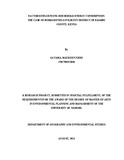| dc.description.abstract | Biomass dominates energy consumption in Sub- Saharan Africa even in relatively well-off
countries such as Botswana and prominent oil producing countries such as Nigeria. The
main consuming sectors are residential, transport, industry and commercial. In the
residential sector, households require energy primarily for cooking, lighting and space
conditioning. In Africa, cooking often accounts between 90 -100% of household energy
consumption due to limited space conditioning loads. The amount and type of energy that a
household consumes depends on age, education, number of cooking times, household size
and costs of energy. The main objective of this study was to establish factors affecting
household consumption of biomass fuels in Kikuyu District, located in Kiambu County,
Kenya. Specifically the study set out to investigate how age, education level of the
household head, daily cooking frequency, household size and energy cost affects
household’s biomass energy consumption; The study was based on the null hypothesis that
there was no significant relationship between age of household heads, education level of
household head, daily cooking frequency, household size and cost of energy and the
amount of biomass energy consumed by households. The study applied a survey design and
was based on a stratified random sample of 198 households drawn disproportionately from
the six wards in the district. The study used questionnaires to collect data from the sample.
Simple regression analysis method is used to analyze the data with the use of SPSS as a
platform to analyze the data collected from the field.
Data analyses revealed that the most significant factors that affected household biomass
energy consumption is the cost of energy at 73.4% followed by household size at 63.8%
then daily cooking frequency with 59.8% and age with 54.6%. The education level of the
household head was not a significant factor as revealed by the analysis. Majority of the
respondents (32.8%) indicated that their households spent between Kshs. 1000 to Kshs.
1500 per month for the purchase of biomass energy for household use while majority of
households comprised of household ranging from four to five members. Majority of
households cooked thrice a day and the majority age group was the age bracket of 40-49
years.
The study concluded that energy cost, household size, daily cooking frequency and age
determine biomass energy consumption in Kikuyu District. This accounts a total average of
50.5% of the factors that affect biomass energy consumption with the leading factor being
energy cost. The study recommends further studies that account for 49.5% of other factors
influencing household biomass energy consumption. The study also recommended that
energy price regulatory policies be set up to ensure that households can have access to
biomass energy | en_US |

